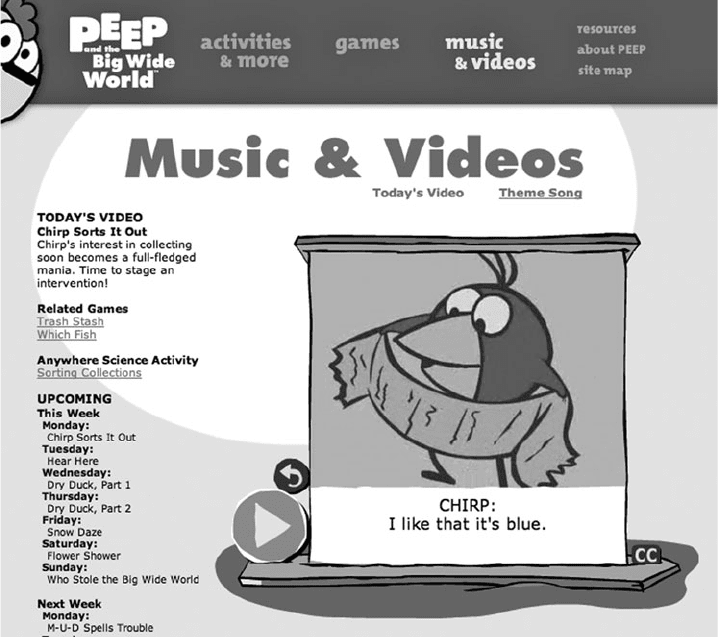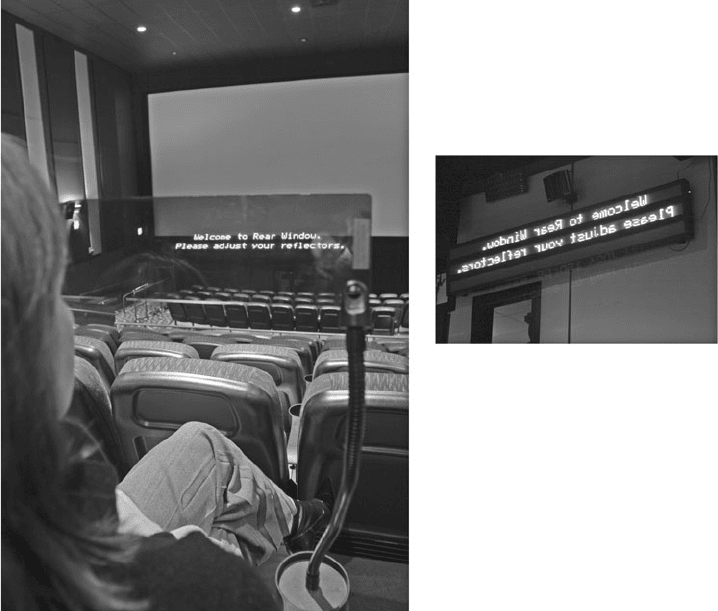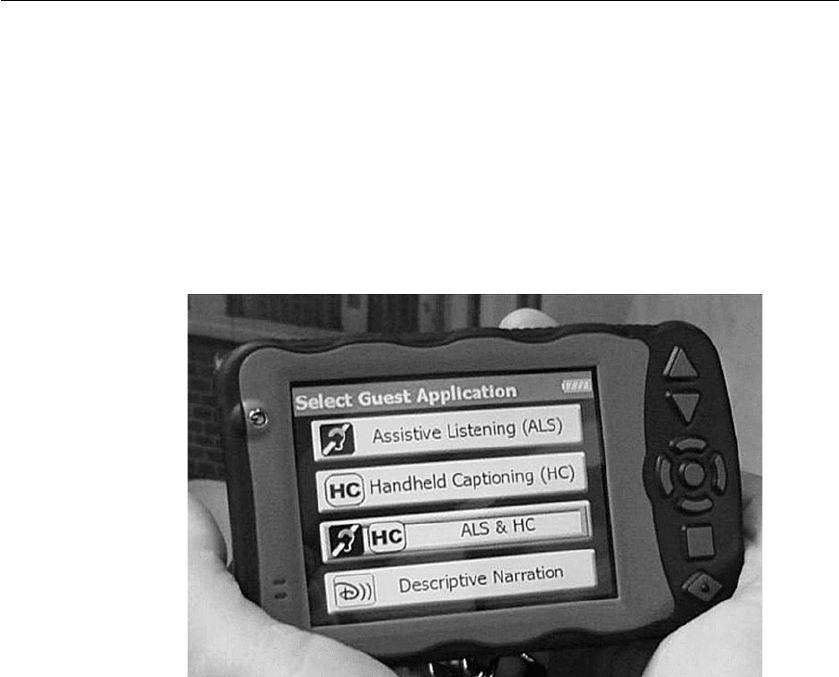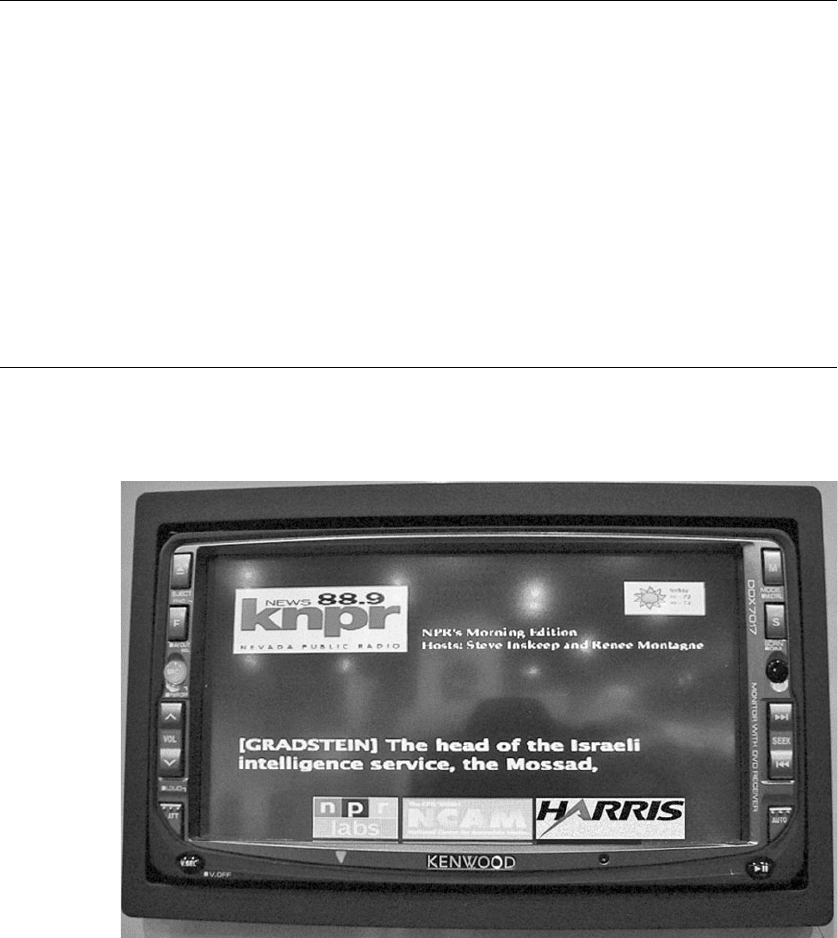Preiser W., Smith K.H. Universal Design Handbook
Подождите немного. Документ загружается.


33.6 PUBLIC SPACES, PRIVATE SPACES, PRODUCTS, AND TECHNOLOGIES
Caldwell, B., M. Cooper, L. Guarino-Reid, and G. Vanderheiden, Web Content Accessibility Guidelines (WCAG)
2.0, W3C (MIT, ERCIM, Keio), 2008a; www.w3.org/TR/WCAG.
———, ———, ———, and ———, Techniques for WCAG 2.0, W3C (MIT, ERCIM, Keio), 2008b; www
.w3.org/TR/WCAG.
Craig, J., M. Cooper, L. Pappas, L. Seeman, and R. Schwerdtfeger, Accessible Rich Internet Applications
(WAI-ARIA) Working Draft, W3C (MIT, ERCIM, Keio), 2009; www.w3.org/TR/wai-aria.
Richards, J., J. Spellman, and J. Treviranus, Authoring Tool Accessibility Guidelines (ATAG) 2.0 Working Draft,
W3C (MIT, ERCIM, Keio), 2009; www.w3.org/TR/ATAG20/.
United Nations, Convention on Rights of Persons with Disabilities, 2008; www.un.org/disabilities/convention/
conventionfull.shtml.
33.12 RESOURCES
How to Meet WCAG 2.0, A Customizable Quick Reference to Web Content Accessibility Guidelines 2.0
Requirements (Success Criteria) and Techniques; http://www.w3.org/WAI/WCAG20/quickref/.
WCAG 2.0 at a Glance; http://www.w3.org/WAI/WCAG20/glance/.
Web Accessibility Initiative (WAI), http://www.w3.org/WAI/.
World Wide Web Consortium (W3C), http://www.w3.org/.

CHAPTER 34
UNIVERSAL DESIGN IN MEDIA
Trisha O’Connell and Larry Goldberg
34.1 INTRODUCTION
People with disabilities have long advocated for technologies and practices that include them in
the media-viewing audience and enable their participation in media-based services. This effort has
resulted in great successes such as television captioning for people who are deaf or hard of hearing
and great frustrations such as inaccessible on-screen menus in DVDs and cable set-top boxes, and
Internet sites that cannot be easily navigated by people who are blind or have low vision.
As analog technologies give way to the all-encompassing digital domain, universally designed
media technologies become more and more possible. Universal, inclusive design also becomes more
and more urgent as media are increasingly integrated into every aspect of our lives. This chapter pro-
vides an overview of media access solutions in the United States, both deployed and in development,
and details opportunities for universal design in new technologies and industry standards.
34.2 TELEVISION AND RADIO ACCESS:
FROM ANALOG TO DIGITAL
Television Closed Captioning
In 1972, the WGBH Educational Foundation aired the first television program with open captions
for deaf and hard-of-hearing viewers. By 1980, a collaborative public/private sector effort produced
the “line-21” closed-captioning system that embeds caption data in the analog signal to be decoded
in the home by set-top decoder boxes. These stand-alone set-top decoders were the antithesis of uni-
versal design—separately purchased, difficult to install, and expensive. Low decoder sales hampered
the growth of captioned programming as many networks and producers pointed to low sales as an
indication of lack of interest in, and need for, captioning. At the same time, the rapid growth of cable
networks in the 1980s made captioned programming hard to find in a 300+ channel universe. In
response, Senator Tom Harkin of Iowa and Representative Edward Markey of Massachusetts enabled
passage of the Television Decoder Circuitry Act of 1990 which mandated built-in closed-caption
decoding capability in all television sets 13 in. or larger sold in the United States Congress ruled
that inclusion of caption decoding capabilities in most TVs represented a minor manufacturing cost
due to economies of scale, while the benefits to people who are deaf or hard of hearing, and people
learning English as a second language, were significant.
Today, built-in caption decoding capability is cited as one of the best examples of universal
design in widespread use, right after the sidewalk curb cut. It is important to note, however, that it
took an act of Congress to achieve, and it did not solve the problem of the failure of market forces to
34.1

34.2 PUBLIC SPACES, PRIVATE SPACES, PRODUCTS, AND TECHNOLOGIES
foster the growth of captioning. Although the Decoder Act created a huge installed base of potential
end users in rapid fashion and created an industry standard for formatting caption data (EIA-608),
many local TV stations, syndicators, and basic cable networks lagged behind in providing captions.
Consequently, consumers and their advocates succeeded in adding a little-noticed requirement for
closed captioning of virtually all TV programs in the Telecommunications Act of 1996 (Telecomm
Act), the nation’s first major rewrite of communications law since 1934. With billions of dollars at stake
for industry in the other provisions of the Telecom Act, captioning requirements did not generate much
controversy. Once the act was passed, the Federal Communications Commission (FCC) established a
compliance schedule, and today, except for certain narrow exemptions, U.S. TV broadcasters, cable-
casters, and satellite TV providers are required to caption nearly 100 percent of their programming.
Television—Video Description
Video description also began at WGBH where it was launched in 1990 under its trademark,
Descriptive Video Service or DVS. The service provides descriptive narration, inserted within the
natural pauses in dialogue, that communicates key visual elements such as actions, settings, gestures,
FIGURE 34.1 WGBH’s Design Squad TV program with sample
video description: “In the workshop, one of the kids wears a face mask,
a protective jacket and gloves. Using a chopsaw, she lowers the blade
and sparks fly from the cutting table.”
Long description: This photo shows a Design Squad contestant in the
workshop. She wears a face mask, a protective jacket, and gloves. Using
a chopsaw, she lowers the blade and sparks fly from the cutting table.

UNIVERSAL DESIGN IN MEDIA 34.3
facial expressions, scene changes, and on-screen text. It is provided free via broadcast, cable and sat-
ellite by public television and, to a limited extent, by commercial networks such as CBS and Fox.
Funding for most broadcast and cable description is provided by the U.S. Department of Education,
but is restricted to programming appropriate for use in the classroom. The Telecom Act recognized the
need to support the growth of video description and directed the FCC to “assess appropriate methods
and schedules for phasing video descriptions into the marketplace, technical and quality standards for
video descriptions, a definition of programming for which video descriptions would apply, and other
technical and legal issues that the Commission deems appropriate.” This led to an FCC requirement
for video description that required four broadcast networks and five cable networks to each provide
video description for 4 hours of programming weekly. This mandate was challenged and overturned
in federal court based on an interpretation of the FCC’s jurisdiction as granted by the Telecom Act.
Consequently, most television programming offered with description is PBS programming such as
Nova, Masterpiece Theater, American Experience, Nature, and many children’s programs as well as
a few hours per week of programming on CBS and Fox. Older movies in the public domain are also
offered with description by the Narrative Television Network on a dedicated cable channel and on
their web site. Efforts to reestablish video description requirements have been constant, and require-
ments are included in pending legislation introduced in Congress in 2008.
Digital Television Transition
With federal funding, WGBH participated in the deliberations of the Advanced Television Systems
Committee (ATSC) to ensure that emerging DTV origination, transmission, and display standards
enabled carriage of closed captions, as required by the Decoder Act and Telecom Act. The DTV
captioning standard, EIA-708, includes many new capabilities such as up to 63 caption services,
viewer-sizable fonts, multiple font choices, multiple caption windows, and additional color, border,
and drop shadow options. As of 2009, user-controlled caption styles are widely available as TV
providers translate 608 caption data into 708 data for inclusion in digital TV signals. Government-
subsidized converter boxes have been made available for Americans who own analog TV sets and
who do not want to purchase new DTV sets or cable TV services. These converters are required to
support 608 caption decoding, and many offer 708 caption features as well.
DTV also holds great promise to make descriptive video widely accessible to consumers. In ana-
log broadcasts, DVS was broadcast via the Second Audio Program (SAP) which meant the viewer
had to have a stereo TV or a stereo VCR that included the SAP feature. Digital television, however,
supports multiple audio tracks and offers built-in access to descriptive video.
Yet finding caption and description controls on new DTV sets or on DTV converter boxes is not
always easy. Also, many viewers who subscribe to cable or satellite experience caption or descrip-
tion problems caused by carriers’ inadvertent errors passing through the signal. This illustrates how
access features can be impacted by both user interface designs and the technology distribution chain.
An FCC task force has been established to address some of the problems encountered by caption and
description users in the new DTV environment.
34.3 MULTIMEDIA AND THE WEB
Multimedia combine dynamic and interactive elements such as text, audio, video, graphics, and
animation and are most commonly packaged within DVDs, web-delivered software, or dedicated
web sites. Accessibility requirements include text display of captions of audio, description of static
and dynamic images and video, and accessible user interfaces. Solutions depend on adherence to the
W3C’s Web Content Accessibility Guidelines (WCAG 2.0) and the authoring of accessible videos,
pdf’s, Flash, and other media.
Currently, the major formats for providing media via the web—QuickTime, Flash, Windows
Media, and RealMedia—can all support captions and descriptions and provide user controls. WGBH

34.4 PUBLIC SPACES, PRIVATE SPACES, PRODUCTS, AND TECHNOLOGIES
has produced a suite of web caption and description web tools, (i.e., MAGpie, CaptionKeeper, CC
for Flash) to foster creation of accessible web-based media. However, proprietary media technologies
create challenges related to conversion and reuse of access tracks for different platforms and distribu-
tors. In 2008, the Society for Motion Picture and Television Engineers (SMPTE) established a work-
ing group for development of an interoperable caption format for media files. The W3C’s Timed Text
Working Group is also defining a nonproprietary text-display format, known as DFXP (Distribution
Format Exchange Profile), for captions and subtitles. Similarly, the Advanced Television Systems
Committee Mobile/Handheld S4 working group is defining packaging and distribution methods for
captions and descriptions as broadcasters and third-party providers begin to utilize the DTV parallel
multimedia broadcast networks to transmit content directly to mobile devices.
Overall, new multimedia technologies are deployed well in advance of both access solutions and
standards. Constant attention and development is needed to catch up to new technologies and influ-
ence production practices. For example, the distribution of movies via download from such web sites
as NetFlix, Amazon, Blockbuster, and others has been frustrating to consumers since none of these
movie services carry captions or descriptions. This is despite the fact that captions and descriptions
have been created for most films by WGBH’s movie theater access system, MoPix, or captioned for
FIGURE 34.2 Captioned Web Media on WGBH’s PEEP and the Big Wide World site.
Long description: This image shows a page from the PEEP and the Big Wide World web site. The page is titled Music
and Videos. A media player shows an animated video of Chirp, a small round bird with a pointed beak. Below the video,
captions read, “Chirp: I like that it’s blue.”

UNIVERSAL DESIGN IN MEDIA 34.5
the DVD release of almost all major movie titles. The lack of described movies via web download
is particularly frustrating since, unlike captioning, DVDs are not carrying description. In the early
1990s, the DVS Home Video service was created by WGBH with federal funds to distribute open-
described VHS home videos through a mail order service. As federal funding for DVS Home Video
was eliminated, the DVD format held the promise of easy provision of an additional audio track con-
taining video description on mainstream DVDs. Unfortunately, problems related to lack of available
disk space (due to the inclusion of director’s commentaries and other DVD special features) have
kept description tracks from being included on most mainstream DVD movies. This is an unfortunate
illustration of how technology and industry standards can enable universal design only to be derailed
by existing production and business practices. A number of major studios are reviewing these poli-
cies, and expected updates on availability of DVS on DVDs will be posted on NCAM’s web site.
34.4 PENDING MEDIA ACCESSIBILITY REQUIREMENTS
As video programming migrates to desktop computers, laptops, and handheld devices, decade-old
legislative requirements for television accessibility no longer apply. Yet there are tremendous oppor-
tunities for universal design as the consumer electronics industry and the computer industry become
competing or complementary gateways to the same media. Two potentially transformative national
activities may help bridge these gaps as well as the problem of inaccessible user interfaces offered
by new digital media devices (HDTVs, Blu-ray DVD players, digital video recorders, electronic
program guides, and other home media components).
In 2008, recommendations for updates to Section 508 of the Rehabilitation Act and Section 255
of the Telecommunications Act were made by the U.S. Access Board’s Telecommunications and
Electronic and Information Technology Advisory Committee (TEITAC). These recommenda-
tions covered media accessibility among many other topics and will inform a Notice of Proposed
Rulemaking for public comment prior to the issuance of final standards and guidelines.
Also in 2008, the disability community renewed efforts to secure legislative mandates for acces-
sible services and technologies with the introduction of the 21st Century Communications and Video
Accessibility Act. The act proposes accessibility requirements for Internet captioning, broadcast
video description, and accessible menus in consumer electronics equipment. As of this writing, pas-
sage of this bill in 2010 is a major priority for many disability-focused organizations.
34.5 THEATRICAL MOTION PICTURES ACCESS:
FROM FILM TO D-CINEMA
People with hearing or vision loss are eager to experience movies in theaters independently and
enjoy first-run movies at any time in any theater, with the same freedom and flexibility as their
friends and families. This remained an elusive goal until 1992 when WGBH’s “Motion Picture
Access” project (MoPix) was funded by the U.S. Department of Education. MoPix design criteria
were developed in collaboration with disabled consumers, membership organizations, advocates,
and industry. Consumers, theater exhibitors, and film distributors set technical and aesthetic criteria
for personalized access and iterative field tests in theaters with deaf, hard-of-hearing, blind, and low-
vision consumers ensured ease of use.
The resulting two technologies are installed at hundreds of theaters (including IMAX theaters and
theme parks) throughout the United States. DVS Theatrical delivers video description via infrared
or FM listening systems, enabling blind and visually impaired moviegoers to listen using headsets
without disturbing other audience members. The Rear Window Captioning system displays reversed
captions on a light-emitting diode (LED) text display which is mounted in the rear of a theater. Deaf
and hard-of-hearing patrons use transparent plastic panels attached to their seats to reflect the cap-
tions so that they appear superimposed on the movie screen. The reflective panels are portable and

34.6 PUBLIC SPACES, PRIVATE SPACES, PRODUCTS, AND TECHNOLOGIES
adjustable, enabling the caption user to sit anywhere in the theater. The system makes it possible for
movie exhibitors to provide closed captions for those who need or desire them without displaying
them to the entire audience, and without the need for special prints or separate screenings.
Currently, synchronized display of captions and delivery of descriptions to headsets is enabled by
a theater’s digital sound system which is operated separately from the film projector. A digital audio
system reader reads a time-code track printed on the film and signals the digital audio to play the
audio in sync with the film. This technology has been adapted to synchronize caption and descriptive
narration tracks with the audio track and to send the captions to the LED display and the descriptive
narration to an infrared or FM emitter.
However, new technologies are transforming the process and the equipment used in the creation,
distribution, and display of movies. Among other things, digital cinema systems integrate digital
audio directly into the digital film file, making it unnecessary for theaters to purchase and main-
tain separate digital audio servers. This means that caption data and description files must now be
embedded directly into a film’s original digital file—a potentially huge advance in universal design
if producers and distributors agree to commission caption and description tracks during file prepara-
tion, as opposed to afterward as is the norm today.
FIGURE 34.3 WGBH’s Rear Window captioning system in a movie theater.
Long description: This photo shows a woman sitting in a movie theater. She reads captions on a transparent acrylic
panel, which is attached to the cup holder in the arm of her seat. At the back of the theater, the captions are shown
backward on an LED screen. The woman’s panel reflects the captions and reverses them so they appear superimposed
on the movie screen.

UNIVERSAL DESIGN IN MEDIA 34.7
WGBH is working within the SMPTE DC28 Engineering Committee to ensure that digital
cinema standards include provisions for captions and description. Systems adhering to these
standards will enable theaters to offer open- or closed-captioned displays and to send captions to
seat-back, handheld, or Rear Window displays and to send description tracks directly to headsets
or for personalized access via handheld devices. The specification also includes other services
long desired by people with disabilities including one for the hard-of-hearing community: an alter-
nate soundtrack that minimizes the music and sound effects that can sometimes overwhelm the
dialogue. The transition to digital cinema systems with the accompanying benefits of standards-
based universal design is occurring somewhat more slowly in the United States than in Europe,
but full availability of “d-cinema” across the United States may be complete within a decade, if
not sooner.
34.6 ENVIRONMENTAL MEDIA
Captioning and description systems also provide access to live events, rides, interactive multimedia
exhibits, and artifacts in museums, theme parks, and sporting venues. Some handheld devices offer
captions and include navigation features as well as user-controlled description. WGBH has enabled
handheld and/or MoPix systems to enhance a visitor’s experience at venues such as the Whitney
Museum of American Art, Disney theme parks, the Baseball Hall of Fame, and national park visitors’
centers across the country.
WGBH has also developed solutions for in-flight entertainment systems to allow air travelers to
access captioned and described media and accessible user interfaces on seat-back displays. As media
installations pervade taxis, bus shelters, hotel lobbies, and countless other public and private places,
equal access to this content will grow in importance.
FIGURE 34.4 Duratech handheld device used in theme parks and museums.
Long description: This photo shows someone’s hands cradling a Duratech handheld device
which is slightly larger than a deck of cards. The device has a screen and several tactile but-
tons. The screen instructs the user to Select Guest Application and offers four options: Assistive
Listening (ALS), Handheld Captioning (HC), ALS and HC, and Descriptive Narration.

34.8 PUBLIC SPACES, PRIVATE SPACES, PRODUCTS, AND TECHNOLOGIES
34.7 RADIO
Hybrid DIGITAL (HD) radio enables broadcast of multiple program channels from a single radio
station as well as text display for captioning and time-shifted, targeted content. These features can
provide easy access to radio reading services as well as new services for users with disabilities,
such as audio description channels and text displays to be used for emergency announcements and
captioning. The development of new radio receiver designs to enable multiple offerings creates an
opportunity to implement accessible controls, displays, and menu options. For blind users as well as
drivers who can not, or shouldn not, take their eyes off the road, a speech input and output interface
for digital radio command and control makes the ultimate universal design sense. For deaf users,
radio text display of essential weather, traffic, or emergency alerts offers significant and critical
safety benefits. WGBH and National Public Radio (NPR) are exploring use of scrolling-text capa-
bilities in HD radios to provide deaf and hard-of-hearing viewers with a “captioned radio” service. A
demonstration of this service was offered during the 2008 Presidential election when NPR’s election
night radio coverage was captioned live by WGBH and fed as scrolling text to prototype HD radio
receivers at participating NPR stations.
34.8 CONCLUSION
The digital age has resulted in an exponential growth in the amount of new media and systems and
a concomitant growth in the vigilance needed to ensure accessibility. In the United States, many of
the leaps forward in media accessibility have been accomplished through federal law, regulations, or
FIGURE 34.5 Captioned HD radio display prototype.
Long description: This photo shows a prototype model of an HD radio able to display captions. A screen on the radio
displays the show title, captions, several logos, and the weather. The title reads, “NPR’s Morning Edition, Hosts: Steve
Inskeep and Renee Montagne.” The caption reads, “[GRADSTEIN] The head of the Israeli intelligence service, the
Mossad…” The logos are KNPR 88.9 Nevada Public Radio, NPR labs, NCAM, and Harris. The weather icon shows the
sun and the current temperature.

UNIVERSAL DESIGN IN MEDIA 34.9
public sector funding. The constantly shifting media environment will likely require further regula-
tory interventions in the coming decades to ensure accessibility. Since new media technologies are
usually developed and proliferated well in advance of potential access regulations, people with dis-
abilities frequently lose ground as each new technology is introduced, in ways that impact education,
public safety, and personal and professional experiences and opportunities.
A commitment to universal design by media technology developers and distributors is critical,
as our global society increasingly relies on media as a key method of communication and learning.
Reaching this goal involves complex interactions of multiple parties, including manufacturers, con-
tent providers, ancillary service providers, and distributors. Engaging early with these stakeholders
is essential, since it takes years of consistent effort to gain traction with all the players, and to design
solutions that can fit the many parallel efforts which eventually converge toward a final product. In
the final analysis, universal design principles must be applied to the education of the next genera-
tion of engineers, designers, software programmers, and media producers to ensure that at the very
moment that each new technology is imagined, the creator’s imagination is universal as well.
34.9 RESOURCES
Advanced Television Systems Committee Mobile/Handheld (ATSC M/H) Candidate Standard; http://www.atsc
.org/standards/candidate_standards.php.
Analog Television (NTSC) closed-captioning standard EIA/CEA-608; http://www.ce.org/Standards/
browseByCommittee_2523.asp.
Digital television (DTV) closed-captioning standard CEA-708; http://www.ce.org/Standards/browseByCommittee
_2525.asp.
FCC Consumer Advisory: Closed Captioning for Digital Television (DTV).
FCC Consumer Advisory Tips On Filing Closed Captioning Complaints.
FCC Report and Order on Television Closed Captioning, 47 CFR Part 791.
FCC Reports and Orders on Implementation of Video Description Rules; Court of Appeals Ruling Overturning
FCC Video Description Rules.
Federal Communications Commission’s Disability Rights Office; http://www.fcc.gov/cib/dro.
Motion Picture Access Project; http://www.mopix.org.
Narrative Television Network; http://www.narrativetv.com.
National Public Radio (NPR)/WGBH Captioned Radio Project; http://www.nprlabs.org/research/accessibleradio
.php.
Section 508 of the Rehabilitation Act of 1973, as amended 29 U.S.C. § 794d; http://www.section508.gov/.
Society of Motion Picture Engineers (SMPTE) Broadband 23B Standards Committee.
Society of Motion Picture Engineers (SMPTE) Digital Cinema (DC28) Engineering Committee.
Telecommunications Act of 1996, Public Law No. 104-104; http://www.fcc.gov/telecom.html.
Television Decoder Circuitry Act of 1990, Public Law 101-431; http://www.fcc.gov/Bureaus/OSEC/library/
legislative_histories/1395.pdf.
Twenty-First Century Communications and Video Accessibility Act-U.S. H.R.6320; http://www.coataccess.
org/node/32.
U.S. Access Board’s Telecommunications and Electronic and Information Technology Advisory Committee
(TEITAC); http://www.access-board.gov/news/teitac-report.htm.
Web access tools: MAGpie, CaptionKeeper, CC for Flash; http://ncam.wgbh.org/webaccess/.
WGBH Educational Foundation: Descriptive Video Service (DVS), http://www.dvs.wgbh.org; The Caption
Center, http://www.caption.wgbh.org; WGBH National Center for Accessible Media (NCAM), http://ncam
.wgbh.org.
World Wide Web Consortium (W3C), Web Content Accessibility Guidelines (WCAG) 2.0; http://www.w3.org/
TR/WCAG20/.
W3C Timed Text Authoring Format 1.0—Distribution Format Exchange Profile (DFXP); http://www.w3.org/
TR/ttaf1-dfxp/.
